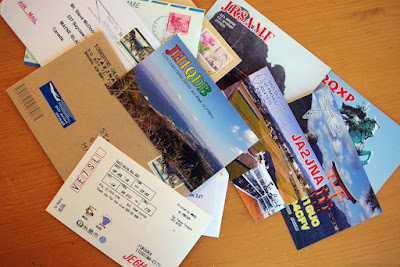Posts Tagged ‘Es’
 6m … Where’d The Magic Go?
6m … Where’d The Magic Go?

This summer's 6m sporadic-E (Es) DX season is now well past the half-way mark and things have been different ... a lot different. For me, the past 40 plus summers of activity on the magic band have always been interesting, if not down right exciting ... particularly when the band opens to Europe from the west coast.
These usually very short-lived paths have been my main interest for the past several years and the bread and butter mode is normally a fast CW exchange, usually taking less than 20 seconds before signals would vanish, as the always quirky west coast path to Europe would jump to another region. But this has all changed dramatically.
I have seen many strong openings involving loud FT8 signals from various parts of North America but when tuning down to the CW/SSB section of the band, found nothing but ghostly silence! Gone are the familiar voices of friends met every summer for decades or the recognition of an old friend's fist on CW ... for me personally, most of the magic was missing this summer. I wonder if this is all part of the natural evolution of amateur radio or does the FT8 revolution signal the long term fate for many of the older conventional modes?
 |
| Track the pole's movement here. |
 |
| July 18th courtesy: http://www.on4kst.org/chat/index.php |
 |
| July 20th courtesy: http://www.on4kst.org/chat/index.php |
 |
| Overnight decodes July 8-9 |
BM6GJL PL02
HL1BRU PM37
HL2IFR PM37
BG4QNE PM01
VR2VAZ OL72
BV2FB PL05
BV6CC PL03
BV1EK PL05
BM3GFU PL04
Thanks to Paul, K7CW, for doggedly sorting through my all-night decode file which may be viewed in full here.
With just a couple of weeks left in the normal Es season, it will be interesting to see if FT8's extra few db will extend it longer than usual!
 Magicband Morphs
Magicband Morphs
 |
| Chordal Hop courtesy: http://g4fkh.co.uk/projects/lp-experiment/ |
 |
| Inter Layer Ducting courtesy: http://g4fkh.co.uk/projects/lp-experiment/ |
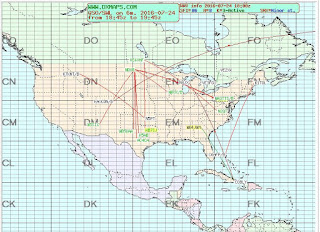 |
| courtesy: http://www.dxmaps.com/ |
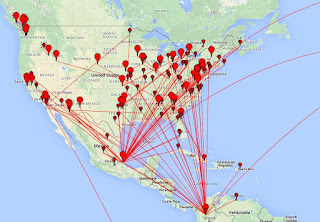 |
| courtesy: https://pskreporter.info/pskmap.html |
 6m Es – Is It Changing?
6m Es – Is It Changing?
With the summer Sporadic-E season now approaching its midpoint, it looks as though this year may be another poor one. Having been operating on 6m every summer since the early 70's, I'm beginning to believe that we may be seeing some changes in what was once the normal summer pattern.
This summer, I can count on one hand, the number of good solid openings ... openings lasting for several hours. Over the past forty plus years, summers on 'six' for me, here in southwestern BC, were usually very predictable. The last week of May would usually see the start of regular band openings that would quickly escalate to almost daily openings through June and July. It was not uncommon to see the band open all day, into the very late hours and then still be open the next morning. Intense Es from California predominated the 70's and 80's ... much different than the past several summers here. The stronger openings now, when they occur, seem to be more to the southeast, favoring Colorado and other nearby central states. At times, this will turn into double-hop to the southeastern states, usually favoring the 'EM' grids.
Really long-haul openings have also taken on a different flavor. For more than two decades, openings to Japan on Sporadic-E almost always occurred late at night, near midnight ... late afternoon for the JAs'. The openings rarely favored anything other than the west coast. Openings to Europe from the west coast were, for the most part unheard of, and any claims of summer-time EU contacts were often dismissed as 'wishful thinking' and not taken too seriously.
A huge shift in long haul Es over the past decade has pretty much re-written the rules of what we have always taken to be 'normal'. Summertime openings to Europe, from the west coast, have now become a regular expectance and, although still rare and usually short-lived, somewhat dependable. Our midnight openings to Japan have largely disappeared ... replaced by hour-long, mid-afternoon or dinner-hour JA runs, and more often than not, right over our west coast heads to any U.S. call district fortunate enough to be in the propagation's hot-spot. All of this is so very different than the 70's and 80's!
So why are things different now? Is it subtle influences from our ever-changing sun?
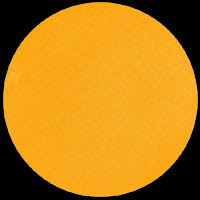
We are now heading into our sixth straight day of a spotless sun, but in reality, solar activity has been slowly winding down for the last several years. Long term studies tend to show that the solar cycle has little effect on summertime Es, but maybe not.
Is it climatic change ... global-warming? The e-layer is supposedly high above any weather influence yet there is evidence pointing to Es being associated with lightning storms and high altitude plasma-driven sprite activity. Maybe global-warming includes ionospheric changes as well and perhaps weather plays more of a role than previously thought.
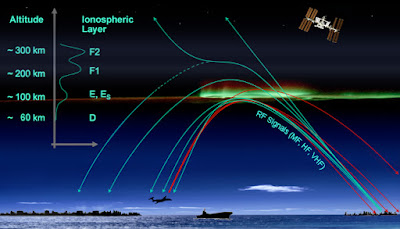 |
| Courtesy: http://www.astrosurf.com/luxorion/qsl-perturbation.htm |
Is it changes in equipment, with an ever-increasing number of 6m stations sporting huge antenna systems and higher ERPs' than ever before?
| Six 7-el Stacked Yagis At W7EW |
Maybe it's the influence of the Internet on operating practices? There is no doubt that having the ability to watch and follow realtime propagation paths, by the very minute, has made a huge difference in operating strategies ... along with big payoffs when it comes to catching those fleeting openings that would likely otherwise have gone unnoticed. On more than one occasion, I have worked Europeans on a seemingly 'dead band', with no propagation indicators at all ... just an announcement on the Internet that said station was calling 'CQ' at the time. Perhaps nowadays, there are just more savvy operators with good stations and a much better understanding of the DX possibilities ... slowly wringing out the best of what 6m has to offer. Maybe it's a combination of several factors.
Let me qualify my observations by saying that these have been my experiences and perhaps unique to the PNW and southwest VE7 only. Longtime Es data-collector, WA5IYX (Pat) in Texas, graphically shows the yearly Es variance in his region. The pattern appears somewhat sinusoidal in nature over the past few decades, but except for the occasional 'stinker', the variances from one summer to the next are not huge.
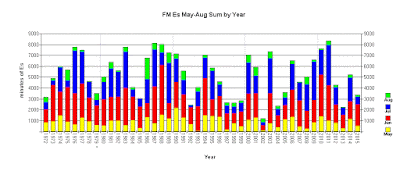 |
| Annual Es At WA5IYX courtesy: http://www.qsl.net/wa5iyx/ |
Are my observations similar to what you may have observed over the past many years? Are the changes real or only imagined? As with most global events being driven by mother nature and continually dynamic, I see no reason why 6m propagation should remain constant from decade to decade ... but I'd sure like to see a little more of it.
Now, usually when I voice complaints about our bad 6m propagation, it seems that things often flip from terrible to amazing soon after. The best Es of the summer often peaks in or close to the first week of July, now fast approaching. Let's hope that this is one 'constant' that hasn't changed as well!
**********************************
Wouldn't you know it. I put above blog together on Tuesday evening, intending to publish it on Wednesday. Early Wednesday morning, before 0900 local time, several Europeans were worked on CW ... perhaps the propagation gods were looking over my shoulder?
As is so often the case with these relatively new types of openings between EU and the west coast, there were no particular propagation clues from this end, other than a brief reception of the KØGUV/b in Minnesota. I was only alerted by the EU propagation reaching as far west as Colorado (KØGU) and a posting on the ON4KST 6m propagation logger that K7RWT in Oregon was hearing the VA5MG/b, sometimes a precursor to PNW propagation over the pole. The propagation map at the time shows no real indicators out this way ... once again, the value of realtime prop-watching via the Internet seems to have played a big role in finding these types of openings.
 |
| courtesy: http://www.on4kst.org/ |
 SLOWLY declining solar activity
SLOWLY declining solar activity
The slide down from a solar maximum is (usually) slower than the climb from the minimum to the maximum. Very gradually, the sun is going “off the boil” and solar activity is slowly falling away. With each year for several years to come things will get progressively harder on the higher bands. Some are predicting the next maximum may be a “damp squib”, so enjoy the conditions while they last. It is quite possible that 10m will never be as good again in the lifetimes of many of us. Certainly 10m is already not as good as a year ago. Although Es is good at any part of the cycle in late spring and summer, F2 DX is best around the peak of solar activity. In the past 6m has supported worldwide DX at times, but I think those days are sadly over.
 So just how sporadic is sporadic E (Es)?
So just how sporadic is sporadic E (Es)?
Time and again I have been struck by just how unsporadic Es is. OK, good days are random but there seems to be a pattern that more northerly and Scandinavian stations on 10m and 6m are better later in the day and later in the season. I actually wonder if these more northerly reports really are Es at all. There is every chance I am totally wrong, but I have noticed this over several summers and I question that Es is truly “sporadic”. I’d be interested to hear the views of others on this.
One thing is certain: we still have a great deal to learn about E-layer DX propagation. Es is certainly a fact on many summertime EU QSOs on the higher HF bands and 6m, but I am sure the multi-hop explanation for some very long distance QSOs is not right.
 10m WSPR – excellent across Europe this afternoon
10m WSPR – excellent across Europe this afternoon
WG2Z (5600km) copied me just once at lunchtime – he may have copied me more times if I was operating on the correct frequency initially – but this afternoon 10m has been in excellent Es shape today with stations from across the continent copyable after lunch with a few G stations copied out to 184km by tropo or plane reflection.
 |
| 10m WSPR unique reports since lunch today (repeats not shown) |
 6m – past the best?
6m – past the best?
I am beginning to think that 6m is now past its best both for Es opportunities and, of course, for F2 propagation. Almost zero Es on 6m in the last few days, mainly locals and a little GDX. I may give it a few more days before QSYing back down to 10m where both Es and F2 DX are more plentiful.
10m conditions should be good for N-S F2. Sunspot count is 256 (high) and 20-30MHz propagation is forecast to be “normal”.
If anything, solar activity has staged a bit of a comeback lately, but this may be just a blip.
UPDATE 1545z: As if to persuade me to stay on 6m, CN8LI (2113km) was spotted at 1450z.
UPDATE 1810z: No more Es here since CN8LI at 1450z. One blog reader tells me that I should try JT65 as there is more activity. JT9-1 worked well for me on MF with international 2-way QSOs with very low mW ERP. I think JT65 is more commonly used on 6m?
